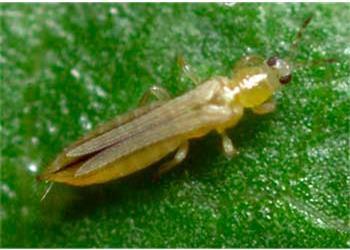Western flower thrips Frankliniella occidentalis
WFT is found on vegetables, ornamentals and fruit throughout Australia. When found in low densities, populations are mainly males, but females develop when the population becomes more dense. Western flower thrips are more numerous in mid to late summer although in both protected and outdoor crops they can be found throughout the year. WFT females range in size from 1.4mm to 1.8mm, and males from 0.9mm to 1.1mm. A darker, slightly larger form of WFT may be seen in winter. There is a distinctive black tip on the females abdomen.
WFT are usually found in flowers, where they feed on nectar and pollen. In flowers, feeding causes silvering, streaking, bronzing or distortion of petals or sepals. Feeding scars on immature fruit can result in distortion of the fruit as the fruit is unable to elongate evenly around the scar tissue. WFT is a primary vector of tomato spotted wilt virus, which can cause major problems in a wide range of crops such as tomato, capsicum, egg-plant, potato, ornamentals, lettuce, cymbidium orchids, melon, and cucumber to name but a few.
Western flower thrips can be controlled with Orius, Cucumeris, Hypo-A and Dalotia.

Related products
Related crops
- Berryfruit
- Flowers/ornamentals
- Greenhouse capsicums
- Greenhouse cucumbers
- Greenhouse eggplants
- Greenhouse tomatoes
- Herbs
- Nursery
- Strawberries




